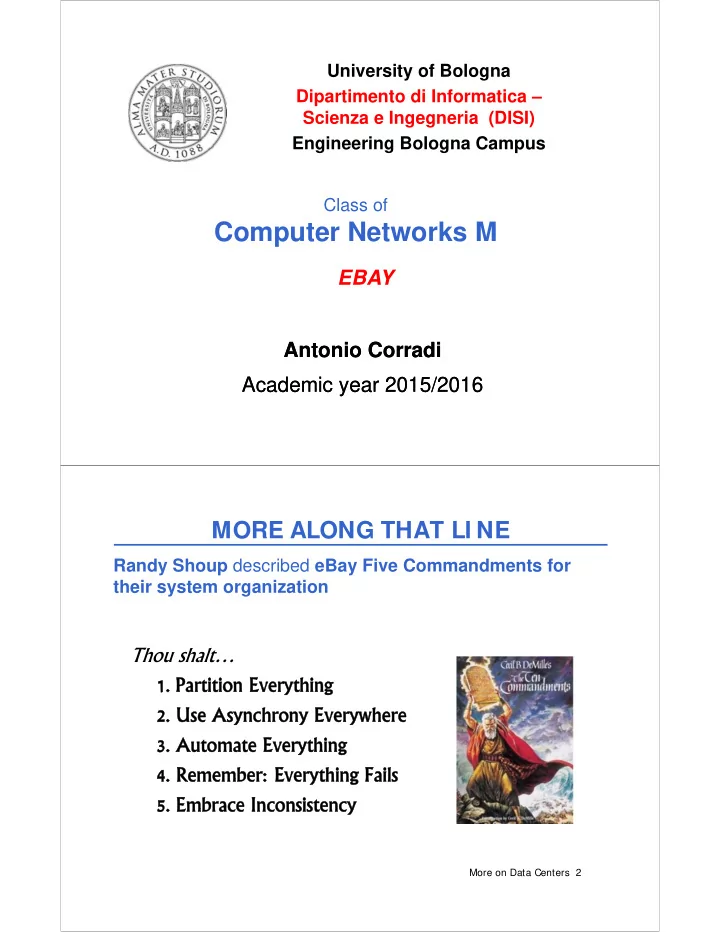

University of Bologna Dipartimento di Informatica – Scienza e Ingegneria (DISI) Engineering Bologna Campus Class of Computer Networks M EBAY Antonio Corradi Antonio Corradi Academic year 2015/2016 Academic year 2015/2016 MORE ALONG THAT LI NE Randy Shoup described eBay Five Commandments for their system organization Thou shalt… 1. Partition Everything 1. Partition Everything 2. Use Asynchrony Everywhere 2. Use Asynchrony Everywhere 3. Automate Everything 3. Automate Everything 4. Remember: Everything Fails 4. Remember: Everything Fails 5. Embrace Inconsistency 5. Embrace Inconsistency More on Data Centers 2
Introduzione 3 1 - Partition Everything Pattern: Functional Segmentation • Segment processing into pools, services, and stages • Segment data along usage boundaries You should split anything you can in separated localities No large components (to be kept consistent) Introduction 4
1 - Partition Everything Pattern: Horizontal Split • Load-balance processing all servers are created equal within a pool • Split (or “shard”) data along primary access path partition by range, modulo of a key, lookup, etc. Introduction 5 1 - Partition Everything The principle suggests to simplify the management Corollary: No Session State • User session flow moves through multiple application pools • Absolutely no session state in application tier Keep it simple (and short in time) Introduction 6
2 - Asynchrony Everywhere Pattern: Event Queue • Primary use-case produces event transactionally such as Create event (ITEM.NEW, ITEM.SOLD) with primary insert/update • Consumers subscribe to event At least once delivery, No guaranteed order with idempotency and readback Introduction 7 2 - Asynchrony Everywhere Pattern: Message Multicast • Search Feeder publishes item updates, by reading item updates from primary database, and it publishes sequenced updates via Scalable Reliable Multicast-inspired protocol • Nodes listen to assigned subset of messages, by the update of in-memory index in real time and request recovery (NAK) when messages are missed Introduction 8
3 - Automate Everything Pattern: Adaptive Configuration • define SLA for a given logical consumer such as 99% of events processed in 15 seconds • dynamically adjust configuration to meet defined SLA Introduction 9 3 - Automate Everything Pattern: Machine Learning • Dynamically adapt search experience Determine best inventory and assemble optimal page for that user and context • Feedback loop enables system to learn and improve over time Collect user behavior Aggregate and analyze offline Deploy updated metadata Decide and serve appropriate experience • Perturbation and dampening Introduction 10
3 - Automate Everything Introduction 11 4 - Everything Fails Pattern: Failure Detection • Servers log all requests Log all application activity, database and service calls on multicast message bus Over 2TB of log messages per day • Listeners automate failure detection and notification Introduction 12
4 - Everything Fails Pattern: Rollback • Absolutely no changes to the site that cannot be undone (!) The system does take any action in case irreversible actions are to be taken • Every feature has on / off state driven by central configuration Feature can be immediately turned off for operational or business reasons Features can be deployed “ wired-off ” to unroll dependencies Introduction 13 4 - Everything Fails Pattern: Graceful Degradation • Application “marks down” an unavailable or distressed resource Those resources are dealt with specifically • Non-critical functionality is removed or ignored All unneeded functions are neither considered nor generally supported • Critical functionality is retried or deferred All critical points are dealt with specifically and in case of success no problem, in case of a failure, retried until completed Introduction 14
5 - Embrace Inconsistency • Choose Appropriate Consistency Guarantees According with Brewer’s CAP Theorem prefer eventual consistency to immediate consistency To guarantee availability and partition-tolerance, we trade off immediate consistency Avoid Distributed Transactions • eBay does absolutely no distributed transactions – no two-phase commit • minimize inconsistency through state machines and careful ordering of operations • eventual consistency through asynchronous event or reconciliation batch Introduction 15
Recommend
More recommend